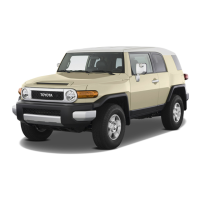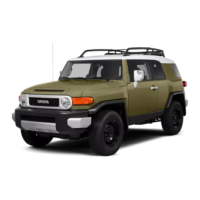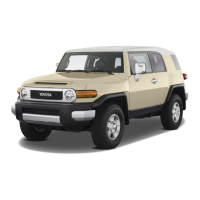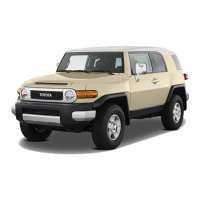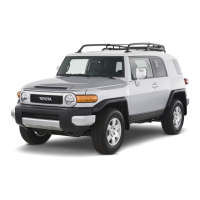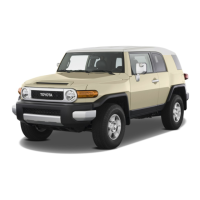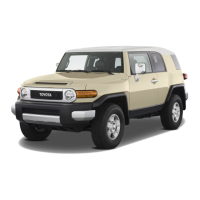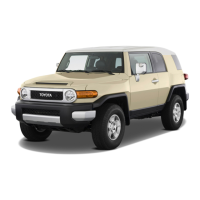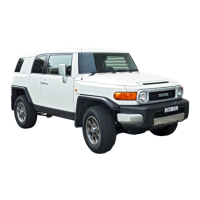




Do you have a question about the Toyota FJ cruiser and is the answer not in the manual?
Covers all models and equipment, including options. Specifications are current at printing.
Using non-genuine parts may affect safety, performance, and durability. Toyota not liable.
Computers record data like engine speed, brake status, vehicle speed. Data varies by grade and options.
EDR records crash data for understanding system performance. Data includes system operation, acceleration, and speed.
Drive defensively, anticipate others, stay focused. Avoid distractions like phone use or adjusting controls.
Never leave children unattended. Dangers of heat build-up/cold. Children may start vehicle or injure themselves.
Details master keys, valet key, and key number plate. Notes on aircraft use and preventing key damage.
Used to lock/unlock vehicle from outside. Includes operation signals, lock buzzer, key battery depletion, security feature.
Vehicle can be locked/unlocked via remote, key, or door lock switch. Details driver's and passenger's switches.
Explains how to open the access door (rear door) using the inside handle and front door. CAUTION for closing.
Can be locked/unlocked via key, remote control, or door lock switch. Explains key operation for glass hatch.
Explains how to open and close the glass hatch. Notes on rear wiper operation and key lockout.
Details seat position, cushion angle, height, and seatback angle adjustments. Also active head restraints.
Explains how to fold down rear seatbacks, including removing head restraints and bottom cushions.
Details adjusting and removing head restraints for front and rear seats. Includes height adjustment for front seats.
Details correct use, fastening, releasing, adjusting belt height, and pretensioners. CAUTIONS for proper use.
Details how to adjust steering wheel position. CAUTION about adjusting while driving and after adjustment.
Reduces glare from headlights. Manual and auto modes available. Includes height adjustment and sensor error prevention.
Details mirror angle adjustment for power-adjustable (LHD/RHD) and manually adjustable types. Includes folding back.
Explains power window operation using driver and passenger switches. Includes one-touch function and stop operation.
Details lock switch operation for LHD and RHD vehicles to prevent accidental passenger window operation.
Steps for opening fuel filler door and cap for LHD and RHD vehicles before refueling. CAUTION about refueling.
Specifies unleaded gasoline, premium preferred. Avoid improper fuels, metallic additives, methanol blends.
Prevents engine starting if key not registered. Explains indicator light operation and conditions causing malfunction.
Guide to achieving good driving posture: seat position, seatback, steering wheel tilt, head restraint, seat belt.
Explains airbag types, components, warning light, deployment conditions, and precautions for driver/passenger.
Toyota urges child restraint use. Rear seats are safest. Choose system by age/size. Follow installation instructions.
Steps for installing restraints using seat belts or ISOFIX anchors. Includes top strap installation and removing head restraints.
Procedures for starting engine, driving, stopping, parking, and starting on a steep uphill.
Explains LOCK, ACC, ON, START positions. Procedure for starting the engine. CAUTIONS for starting and driving.
Explains shift lever positions (P, R, N, D, 4, 3, 2, L) and their functions. Includes downshifting restrictions and shift lock.
Details operation for left/right turns and lane changes for LHD and RHD vehicles. Notes on indicator flashing.
Instructions for setting and releasing the parking brake. NOTICE before driving: fully release parking brake.
How to sound the horn by pressing the steering wheel. Ensure steering wheel is locked after adjustment.
Identifies and describes gauges: Tachometer, Speedometer, Voltmeter, Engine coolant temp, Fuel, Odometer/trip meter.
Instrument cluster and center panel lights inform driver of vehicle status and system warnings. Lists indicators and warning lights.
Displays Compass, Outside Temp, Clinometer. Buttons for SET, E/M for calibration and mode switching.
Explains manual operation of headlights, side markers, and position lights. Includes high beam operation.
Adjusts headlight level based on passenger and cargo load. Provides guide to dial settings.
Details front fog light switch operation for ON/OFF. Fog lights improve visibility in rain/fog.
Explains operation of rear fog light switch. Used to warn others in bad visibility. Do not use in good visibility.
Adjusts wiper intervals for intermittent operation. Details low/high speed and washer/wiper dual operation.
Explains operation modes: intermittent, normal, washer/wiper dual. Wiper operates 3 times at normal speed before intermittent.
Maintains set speed without accelerator. Explains setting, adjusting speed, canceling/resuming control.
Assists parking via distance sensors and buzzer. Explains back sensors, switch, and detection range.
Assists backing up with guide lines and rear view image. Explains switching screen, description, and troubleshooting.
Explains transfer modes: H2, H4, N, L4. Select mode based on road conditions for optimal traction and economy.
Helps prevent wheel spin on slippery surfaces. Explains system operation, indicator, and when it may not operate.
Used when wheels spin in ditches or on slippery/rugged surfaces. Explains locking/unlocking procedure. CAUTION.
Allows travel on rough off-road surfaces at fixed low speed without pedal use. Minimizes traction loss. CAUTIONS.
Systems like ABS, Brake Assist, VSC, TRC enhance safety/performance. They are supplementary. Explains disabling TRC/VSC.
Utility vehicle class characteristics: higher center of gravity, rollover risk. Higher ground clearance offers better view.
Drive carefully off-road. Avoid risks, grip steering wheel outside rim, check brakes after rough terrain, clear underbody debris.
Stow cargo securely, keep vehicle level. Do not carry unnecessary weight. CAUTION: Do not store flammable items.
Prepare for winter: use appropriate fluids, check battery, fit snow tires/chains. Clear ice from windows/wipers.
Drive slowly in winter. Park with shift lever in P, avoid parking brake if freezing risk. Block wheels if parking brake not used.
Install chains on rear tires only. Follow instructions. Retighten chains after initial driving. Check local regulations.
Improve fuel economy: smooth acceleration/braking, avoid delays, maintain constant speed, use AC only when necessary.
Toyota does not recommend trailer towing or hitch carriers. Vehicle not designed for trailer towing.
Vehicle designed for passengers. Towing affects handling, performance. Consult dealer for towing kits, legal requirements.
Check load limits, secure trailer load, proper trailer ball height, vehicle level. Use supplementary mirrors if needed.
Check connections. Practice driving, reversing. Increase vehicle-to-vehicle distance. Avoid jerky inputs and sharp turns.
Details adjusting temperature, fan speed, selecting air outlets, switching between outside/recirculated air modes.
Feature to defog rear window. Button turns it ON/OFF. Auto shut-off after 15-240 mins. NOTICE to prevent battery discharge.
Describes Type A (external changer) and Type B (changer) CD players with AM/FM radio.
Explains radio controls: PWR·VOL, Seek, AST, AM/FM buttons, Preset stations, AF/TA modes.
Manually and automatically set station presets. Scan preset or all stations within range.
Receive station/program info (classical, news). Network listening (AF-ON/REG-OFF/ON). Select program type.
Explains CD player controls: Eject, Random/Repeat playback, Track selector, Text, Playback buttons.
Explains controls for MP3/WMA playback: File selector, Folder selector, Random/Repeat play, Text, Playback buttons.
Connects iPod via cable for music playback. Turn on iPod power. Select iPod source on audio unit.
Connects USB memory for music playback. Turn on memory power. Select USB source on audio unit.
Displays current mode, changes settings. Type A: Sound quality/volume balance, Auto Sound Levelizer. Type B: Menu navigation.
Enables wireless music playback. Supports Bluetooth®. Lists conditions for system non-operation.
Procedure to register mobile phone: press off-hook, select Setup/BT A Setup, Pair Audio, Record Name, Confirm.
Lists menu items: Setup, Pair Audio, Select Audio, Change Name, List Audios, Set Passkey, Delete Audio, System Setup.
Steps to register, select, change name, list, change passkey, delete players. Also explains phone pairing.
Quick guide to setting up phone, adding entries, dialing by name. Lists functions like making/receiving calls, call history.
Procedure to register mobile phone: press off-hook, select Setup, Phone Setup, Pair Phone, Record Name, Confirm.
Lists menus for CallBack, Redial, Phonebook (Add Entry, Change Name, Delete Entry, List Names, Speed Dial), Setup (Security, Phone Setup, System Setup).
How to dial by name, speed dial, redial, call back. Receiving, refusing, transferring calls. Using call history.
Using call history for dialing, storing in phone book, deleting. Talking on phone precautions against echo.
Registering, selecting, changing name, listing mobile phones. Changing passkey, deleting phone. Explains phone setup.
Setting/changing PIN, locking/unlocking phone book. CAUTIONS for system setup operations.
Adding new numbers, changing registered names, listing data, setting speed dials, deleting entries.
Identifies locations of interior lights: Rear, Center, Personal, and Engine switch light.
Entry system turns lights on/off with doors/engine. Prevents battery discharge if lights stay on.
How to turn personal lights ON/OFF. They turn off automatically after 30 mins if key is removed.
Identifies storage locations: Auxiliary box, Glove box, Bottle holders, Cup holders. CAUTION for items that should not be left.
How to open the glove box. CAUTION: Keep glove box closed while driving to prevent occupant injury.
Details front cup holders and rear cup holders. CAUTION for items unsuitable for cup holders.
Notes bottle fitment. NOTICE for items not to be stowed. Use cargo net hooks and shopping bag hooks.
How to open auxiliary box. CAUTION: Keep auxiliary box closed to prevent injury from falling items.
Explains front sun visor forward/side positions and side sun visor flip down operation.
Instructions on how to open the cover for vanity mirrors.
Clock displays when engine switch is ACC/ON. Resets to 1:00 after battery disconnect. How to adjust hours/minutes.
Displays outside temperature (-40°C to 50°C). Type A/B controls for display ON/OFF and switching C/F.
12V accessory outlets available. Used for accessories running on less than 10A. NOTICE for avoiding damage.
Procedures for washing, waxing, cleaning aluminum wheels, bumpers, moldings. CAUTIONS for exhaust pipe.
Procedures for protecting interior, cleaning leather/synthetic leather areas. CAUTION about water and interior cleaning.
Recommends day-to-day care and regular maintenance. Explains scheduled maintenance and where to go for service.
Details extra service items for operating on rough/muddy roads, dusty roads, or roads with salt. Also for heavily loaded driving.
General precautions for DIY maintenance: battery condition, engine coolant, engine oil, fuses, bulbs, radiator/condenser, tire pressure.
Procedure to open hood using release lever inside vehicle. CAUTION for pre-driving check of hood closure.
Diagram identifying components: Dust cup, Air cleaner, Dipstick, Coolant reservoir, Filler cap, Fuse box, Battery, Radiator, Condenser, Cap, Washer fluid tank.
How to check engine oil level on dipstick. Steps for adding oil, checking dipstick, reinstalling cap. Approx. quantity needed.
Check coolant level between F/L lines when engine cold. Select Toyota Super Long Life Coolant or similar.
Check terminals for corrosion, loose connections. Explains battery caution symbols (acid, sparks, children, explosive gas).
Check interval per schedule. Inspect filter, replace if dirty. Remove filter case, then filter. CAUTION for dust inhalation.
Check treadwear indicators and uneven wear. Replace tires if indicators show. Check spare tire. Rotate tires.
Wheel selection criteria: load capacity, diameter, rim width, inset. Aluminum wheel precautions: use genuine nuts/wrenches, check tightness.
Replace discharged battery with new one. Tools needed: screwdriver, lithium battery. Steps for replacing battery.
Procedure to check/replace fuses if electrical components fail. Fuse locations in engine compartment and under instrument panel.
Describes replacing bulbs yourself. Lists front bulb locations (headlights, fog, turn signals, etc.). CAUTION for replacing bulbs.
Use flashers for malfunctions or accidents. Press switch to flash lights. NOTICE to prevent battery discharge.
Recommend dealer/towing service. Use sling-type truck carefully. Use safety chains. Contact dealer if engine runs but vehicle won't move.
Lists visible (leaks, tire wear, temp/voltmeter issues), audible (exhaust, squeal, noises), and operational (misfire, power loss) symptoms.
System stops fuel supply on collision/airbag inflation. Procedure to restart engine after system activation. Inspect ground.
Calmly perform actions if lights/buzzers activate. Stop vehicle immediately if brake system warnings appear.
Light may activate due to natural causes (leaks, temp changes), temporary spare, or system malfunction.
Procedure for replacing flat tire: stop safely, set brake, shift to P, stop engine, turn on flashers. Location of spare tire, jack, tools.
Troubleshooting steps if engine won't start: check fuel, flooded engine, immobilizer system, battery issues.
New keys can be made by dealer using master key and key number plate. If all master keys lost, immobilizer system must be replaced.
Procedure for jump starting using jumper cables and a second vehicle. Connecting cables, starting/recharging procedure.
Stop vehicle, turn off AC, stop engine. Inspect hoses/radiator for leaks after cooling. Add coolant if needed.
Procedures for stuck vehicle: stop engine, remove obstruction, place material for traction, restart engine, turn off VSC, apply accelerator.
Procedure for emergency stop: brake firmly with both feet, shift to N, stop engine via ACC. CAUTION: Loss of power assist.
Table of dimensions and weights: length, width, height, wheelbase, tread, mass, axle capacity, drawbar load, towing capacity.
VIN is legal identifier. Locations stamped on instrument panel and front right frame. Forbidden to alter VIN.
Details engine model (1GR-FE), type, bore/stroke, displacement, drive belt, valve clearance, max speed, torque, output.
Specifies fuel type (premium unleaded), octane rating. Fuel tank capacity. Oil capacity (with/without filter, with cooler).
Recommends Toyota Genuine Motor Oil or equivalent. Explains oil grade (API, ILSAC) and viscosity (SAE) based on temperature.
Specifies cooling system capacity/type, spark plug type/gap. Electrical: battery specific gravity, charging rates.
Details differential oil capacity/type. Auto transmission fluid capacity/type. NOTICE on using correct ATF.
Specifies transfer oil capacity/type. Brake pedal clearance/play, fluid type. Chassis lubrication for propeller shafts.
Steering free play, fluid type. Tire size, inflation pressure, wheel size, nut torque. Tire certification (India).
Lists exterior and interior light bulbs with wattage and type (A-F) for Type A vehicles.
Use premium unleaded gasoline (95 octane). Temporarily use 91 octane. Avoid improper fuels, metallic additives, methanol blends.
Vehicle has electronic features for personalization. Programming requires dealership equipment. Some settings change others.
Change display color and language of inside rear view mirror. Park safely with parking brake set, shift in P.
Normal system operation requires initialization after battery reconnect or maintenance. Explains when to initialize (tire rotation, size change).
Provides a list of abbreviations and acronyms used in the manual with their meanings (ABS, ACC, AI-SHIFT, A-TRAC, CRS, etc.).
Troubleshooting guide for common problems like flat tire, engine not starting, lost keys, low battery, stuck vehicle, warning lights.
Covers all models and equipment, including options. Specifications are current at printing.
Using non-genuine parts may affect safety, performance, and durability. Toyota not liable.
Computers record data like engine speed, brake status, vehicle speed. Data varies by grade and options.
EDR records crash data for understanding system performance. Data includes system operation, acceleration, and speed.
Drive defensively, anticipate others, stay focused. Avoid distractions like phone use or adjusting controls.
Never leave children unattended. Dangers of heat build-up/cold. Children may start vehicle or injure themselves.
Details master keys, valet key, and key number plate. Notes on aircraft use and preventing key damage.
Used to lock/unlock vehicle from outside. Includes operation signals, lock buzzer, key battery depletion, security feature.
Vehicle can be locked/unlocked via remote, key, or door lock switch. Details driver's and passenger's switches.
Explains how to open the access door (rear door) using the inside handle and front door. CAUTION for closing.
Can be locked/unlocked via key, remote control, or door lock switch. Explains key operation for glass hatch.
Explains how to open and close the glass hatch. Notes on rear wiper operation and key lockout.
Details seat position, cushion angle, height, and seatback angle adjustments. Also active head restraints.
Explains how to fold down rear seatbacks, including removing head restraints and bottom cushions.
Details adjusting and removing head restraints for front and rear seats. Includes height adjustment for front seats.
Details correct use, fastening, releasing, adjusting belt height, and pretensioners. CAUTIONS for proper use.
Details how to adjust steering wheel position. CAUTION about adjusting while driving and after adjustment.
Reduces glare from headlights. Manual and auto modes available. Includes height adjustment and sensor error prevention.
Details mirror angle adjustment for power-adjustable (LHD/RHD) and manually adjustable types. Includes folding back.
Explains power window operation using driver and passenger switches. Includes one-touch function and stop operation.
Details lock switch operation for LHD and RHD vehicles to prevent accidental passenger window operation.
Steps for opening fuel filler door and cap for LHD and RHD vehicles before refueling. CAUTION about refueling.
Specifies unleaded gasoline, premium preferred. Avoid improper fuels, metallic additives, methanol blends.
Prevents engine starting if key not registered. Explains indicator light operation and conditions causing malfunction.
Guide to achieving good driving posture: seat position, seatback, steering wheel tilt, head restraint, seat belt.
Explains airbag types, components, warning light, deployment conditions, and precautions for driver/passenger.
Toyota urges child restraint use. Rear seats are safest. Choose system by age/size. Follow installation instructions.
Steps for installing restraints using seat belts or ISOFIX anchors. Includes top strap installation and removing head restraints.
Procedures for starting engine, driving, stopping, parking, and starting on a steep uphill.
Explains LOCK, ACC, ON, START positions. Procedure for starting the engine. CAUTIONS for starting and driving.
Explains shift lever positions (P, R, N, D, 4, 3, 2, L) and their functions. Includes downshifting restrictions and shift lock.
Details operation for left/right turns and lane changes for LHD and RHD vehicles. Notes on indicator flashing.
Instructions for setting and releasing the parking brake. NOTICE before driving: fully release parking brake.
How to sound the horn by pressing the steering wheel. Ensure steering wheel is locked after adjustment.
Identifies and describes gauges: Tachometer, Speedometer, Voltmeter, Engine coolant temp, Fuel, Odometer/trip meter.
Instrument cluster and center panel lights inform driver of vehicle status and system warnings. Lists indicators and warning lights.
Displays Compass, Outside Temp, Clinometer. Buttons for SET, E/M for calibration and mode switching.
Explains manual operation of headlights, side markers, and position lights. Includes high beam operation.
Adjusts headlight level based on passenger and cargo load. Provides guide to dial settings.
Details front fog light switch operation for ON/OFF. Fog lights improve visibility in rain/fog.
Explains operation of rear fog light switch. Used to warn others in bad visibility. Do not use in good visibility.
Adjusts wiper intervals for intermittent operation. Details low/high speed and washer/wiper dual operation.
Explains operation modes: intermittent, normal, washer/wiper dual. Wiper operates 3 times at normal speed before intermittent.
Maintains set speed without accelerator. Explains setting, adjusting speed, canceling/resuming control.
Assists parking via distance sensors and buzzer. Explains back sensors, switch, and detection range.
Assists backing up with guide lines and rear view image. Explains switching screen, description, and troubleshooting.
Explains transfer modes: H2, H4, N, L4. Select mode based on road conditions for optimal traction and economy.
Helps prevent wheel spin on slippery surfaces. Explains system operation, indicator, and when it may not operate.
Used when wheels spin in ditches or on slippery/rugged surfaces. Explains locking/unlocking procedure. CAUTION.
Allows travel on rough off-road surfaces at fixed low speed without pedal use. Minimizes traction loss. CAUTIONS.
Systems like ABS, Brake Assist, VSC, TRC enhance safety/performance. They are supplementary. Explains disabling TRC/VSC.
Utility vehicle class characteristics: higher center of gravity, rollover risk. Higher ground clearance offers better view.
Drive carefully off-road. Avoid risks, grip steering wheel outside rim, check brakes after rough terrain, clear underbody debris.
Stow cargo securely, keep vehicle level. Do not carry unnecessary weight. CAUTION: Do not store flammable items.
Prepare for winter: use appropriate fluids, check battery, fit snow tires/chains. Clear ice from windows/wipers.
Drive slowly in winter. Park with shift lever in P, avoid parking brake if freezing risk. Block wheels if parking brake not used.
Install chains on rear tires only. Follow instructions. Retighten chains after initial driving. Check local regulations.
Improve fuel economy: smooth acceleration/braking, avoid delays, maintain constant speed, use AC only when necessary.
Toyota does not recommend trailer towing or hitch carriers. Vehicle not designed for trailer towing.
Vehicle designed for passengers. Towing affects handling, performance. Consult dealer for towing kits, legal requirements.
Check load limits, secure trailer load, proper trailer ball height, vehicle level. Use supplementary mirrors if needed.
Check connections. Practice driving, reversing. Increase vehicle-to-vehicle distance. Avoid jerky inputs and sharp turns.
Details adjusting temperature, fan speed, selecting air outlets, switching between outside/recirculated air modes.
Feature to defog rear window. Button turns it ON/OFF. Auto shut-off after 15-240 mins. NOTICE to prevent battery discharge.
Describes Type A (external changer) and Type B (changer) CD players with AM/FM radio.
Explains radio controls: PWR·VOL, Seek, AST, AM/FM buttons, Preset stations, AF/TA modes.
Manually and automatically set station presets. Scan preset or all stations within range.
Receive station/program info (classical, news). Network listening (AF-ON/REG-OFF/ON). Select program type.
Explains CD player controls: Eject, Random/Repeat playback, Track selector, Text, Playback buttons.
Explains controls for MP3/WMA playback: File selector, Folder selector, Random/Repeat play, Text, Playback buttons.
Connects iPod via cable for music playback. Turn on iPod power. Select iPod source on audio unit.
Connects USB memory for music playback. Turn on memory power. Select USB source on audio unit.
Displays current mode, changes settings. Type A: Sound quality/volume balance, Auto Sound Levelizer. Type B: Menu navigation.
Enables wireless music playback. Supports Bluetooth®. Lists conditions for system non-operation.
Procedure to register mobile phone: press off-hook, select Setup/BT A Setup, Pair Audio, Record Name, Confirm.
Lists menu items: Setup, Pair Audio, Select Audio, Change Name, List Audios, Set Passkey, Delete Audio, System Setup.
Steps to register, select, change name, list, change passkey, delete players. Also explains phone pairing.
Quick guide to setting up phone, adding entries, dialing by name. Lists functions like making/receiving calls, call history.
Procedure to register mobile phone: press off-hook, select Setup, Phone Setup, Pair Phone, Record Name, Confirm.
Lists menus for CallBack, Redial, Phonebook (Add Entry, Change Name, Delete Entry, List Names, Speed Dial), Setup (Security, Phone Setup, System Setup).
How to dial by name, speed dial, redial, call back. Receiving, refusing, transferring calls. Using call history.
Using call history for dialing, storing in phone book, deleting. Talking on phone precautions against echo.
Registering, selecting, changing name, listing mobile phones. Changing passkey, deleting phone. Explains phone setup.
Setting/changing PIN, locking/unlocking phone book. CAUTIONS for system setup operations.
Adding new numbers, changing registered names, listing data, setting speed dials, deleting entries.
Identifies locations of interior lights: Rear, Center, Personal, and Engine switch light.
Entry system turns lights on/off with doors/engine. Prevents battery discharge if lights stay on.
How to turn personal lights ON/OFF. They turn off automatically after 30 mins if key is removed.
Identifies storage locations: Auxiliary box, Glove box, Bottle holders, Cup holders. CAUTION for items that should not be left.
How to open the glove box. CAUTION: Keep glove box closed while driving to prevent occupant injury.
Details front cup holders and rear cup holders. CAUTION for items unsuitable for cup holders.
Notes bottle fitment. NOTICE for items not to be stowed. Use cargo net hooks and shopping bag hooks.
How to open auxiliary box. CAUTION: Keep auxiliary box closed to prevent injury from falling items.
Explains front sun visor forward/side positions and side sun visor flip down operation.
Instructions on how to open the cover for vanity mirrors.
Clock displays when engine switch is ACC/ON. Resets to 1:00 after battery disconnect. How to adjust hours/minutes.
Displays outside temperature (-40°C to 50°C). Type A/B controls for display ON/OFF and switching C/F.
12V accessory outlets available. Used for accessories running on less than 10A. NOTICE for avoiding damage.
Procedures for washing, waxing, cleaning aluminum wheels, bumpers, moldings. CAUTIONS for exhaust pipe.
Procedures for protecting interior, cleaning leather/synthetic leather areas. CAUTION about water and interior cleaning.
Recommends day-to-day care and regular maintenance. Explains scheduled maintenance and where to go for service.
Details extra service items for operating on rough/muddy roads, dusty roads, or roads with salt. Also for heavily loaded driving.
General precautions for DIY maintenance: battery condition, engine coolant, engine oil, fuses, bulbs, radiator/condenser, tire pressure.
Procedure to open hood using release lever inside vehicle. CAUTION for pre-driving check of hood closure.
Diagram identifying components: Dust cup, Air cleaner, Dipstick, Coolant reservoir, Filler cap, Fuse box, Battery, Radiator, Condenser, Cap, Washer fluid tank.
How to check engine oil level on dipstick. Steps for adding oil, checking dipstick, reinstalling cap. Approx. quantity needed.
Check coolant level between F/L lines when engine cold. Select Toyota Super Long Life Coolant or similar.
Check terminals for corrosion, loose connections. Explains battery caution symbols (acid, sparks, children, explosive gas).
Check interval per schedule. Inspect filter, replace if dirty. Remove filter case, then filter. CAUTION for dust inhalation.
Check treadwear indicators and uneven wear. Replace tires if indicators show. Check spare tire. Rotate tires.
Wheel selection criteria: load capacity, diameter, rim width, inset. Aluminum wheel precautions: use genuine nuts/wrenches, check tightness.
Replace discharged battery with new one. Tools needed: screwdriver, lithium battery. Steps for replacing battery.
Procedure to check/replace fuses if electrical components fail. Fuse locations in engine compartment and under instrument panel.
Describes replacing bulbs yourself. Lists front bulb locations (headlights, fog, turn signals, etc.). CAUTION for replacing bulbs.
Use flashers for malfunctions or accidents. Press switch to flash lights. NOTICE to prevent battery discharge.
Recommend dealer/towing service. Use sling-type truck carefully. Use safety chains. Contact dealer if engine runs but vehicle won't move.
Lists visible (leaks, tire wear, temp/voltmeter issues), audible (exhaust, squeal, noises), and operational (misfire, power loss) symptoms.
System stops fuel supply on collision/airbag inflation. Procedure to restart engine after system activation. Inspect ground.
Calmly perform actions if lights/buzzers activate. Stop vehicle immediately if brake system warnings appear.
Light may activate due to natural causes (leaks, temp changes), temporary spare, or system malfunction.
Procedure for replacing flat tire: stop safely, set brake, shift to P, stop engine, turn on flashers. Location of spare tire, jack, tools.
Troubleshooting steps if engine won't start: check fuel, flooded engine, immobilizer system, battery issues.
New keys can be made by dealer using master key and key number plate. If all master keys lost, immobilizer system must be replaced.
Procedure for jump starting using jumper cables and a second vehicle. Connecting cables, starting/recharging procedure.
Stop vehicle, turn off AC, stop engine. Inspect hoses/radiator for leaks after cooling. Add coolant if needed.
Procedures for stuck vehicle: stop engine, remove obstruction, place material for traction, restart engine, turn off VSC, apply accelerator.
Procedure for emergency stop: brake firmly with both feet, shift to N, stop engine via ACC. CAUTION: Loss of power assist.
Table of dimensions and weights: length, width, height, wheelbase, tread, mass, axle capacity, drawbar load, towing capacity.
VIN is legal identifier. Locations stamped on instrument panel and front right frame. Forbidden to alter VIN.
Details engine model (1GR-FE), type, bore/stroke, displacement, drive belt, valve clearance, max speed, torque, output.
Specifies fuel type (premium unleaded), octane rating. Fuel tank capacity. Oil capacity (with/without filter, with cooler).
Recommends Toyota Genuine Motor Oil or equivalent. Explains oil grade (API, ILSAC) and viscosity (SAE) based on temperature.
Specifies cooling system capacity/type, spark plug type/gap. Electrical: battery specific gravity, charging rates.
Details differential oil capacity/type. Auto transmission fluid capacity/type. NOTICE on using correct ATF.
Specifies transfer oil capacity/type. Brake pedal clearance/play, fluid type. Chassis lubrication for propeller shafts.
Steering free play, fluid type. Tire size, inflation pressure, wheel size, nut torque. Tire certification (India).
Lists exterior and interior light bulbs with wattage and type (A-F) for Type A vehicles.
Use premium unleaded gasoline (95 octane). Temporarily use 91 octane. Avoid improper fuels, metallic additives, methanol blends.
Vehicle has electronic features for personalization. Programming requires dealership equipment. Some settings change others.
Change display color and language of inside rear view mirror. Park safely with parking brake set, shift in P.
Normal system operation requires initialization after battery reconnect or maintenance. Explains when to initialize (tire rotation, size change).
Provides a list of abbreviations and acronyms used in the manual with their meanings (ABS, ACC, AI-SHIFT, A-TRAC, CRS, etc.).
Troubleshooting guide for common problems like flat tire, engine not starting, lost keys, low battery, stuck vehicle, warning lights.
| Brand | Toyota |
|---|---|
| Model | FJ cruiser |
| Category | Automobile |
| Language | English |

